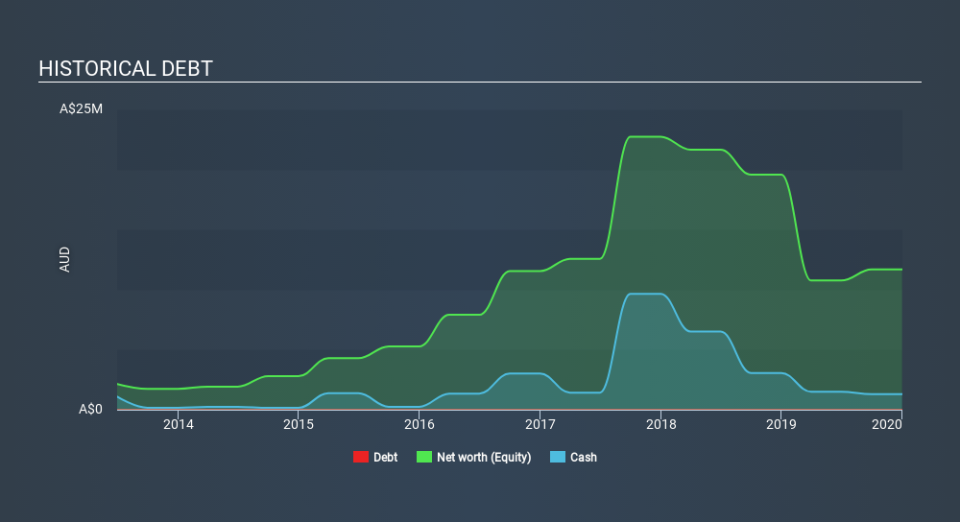Here's Why Kairos Minerals (ASX:KAI) Must Use Its Cash Wisely

There's no doubt that money can be made by owning shares of unprofitable businesses. For example, although software-as-a-service business Salesforce.com lost money for years while it grew recurring revenue, if you held shares since 2005, you'd have done very well indeed. Nonetheless, only a fool would ignore the risk that a loss making company burns through its cash too quickly.
So should Kairos Minerals (ASX:KAI) shareholders be worried about its cash burn? For the purpose of this article, we'll define cash burn as the amount of cash the company is spending each year to fund its growth (also called its negative free cash flow). The first step is to compare its cash burn with its cash reserves, to give us its 'cash runway'.
View our latest analysis for Kairos Minerals
Does Kairos Minerals Have A Long Cash Runway?
A cash runway is defined as the length of time it would take a company to run out of money if it kept spending at its current rate of cash burn. When Kairos Minerals last reported its balance sheet in December 2019, it had zero debt and cash worth AU$1.3m. Importantly, its cash burn was AU$3.3m over the trailing twelve months. Therefore, from December 2019 it had roughly 5 months of cash runway. With a cash runway that short, we strongly believe that the company must raise cash or else douse its cash burn promptly. Importantly, if we extrapolate recent cash burn trends, the cash runway would be noticeably longer. The image below shows how its cash balance has been changing over the last few years.
How Is Kairos Minerals's Cash Burn Changing Over Time?
Because Kairos Minerals isn't currently generating revenue, we consider it an early-stage business. Nonetheless, we can still examine its cash burn trajectory as part of our assessment of its cash burn situation. As it happens, the company's cash burn reduced by 54% over the last year, which suggests that management are mindful of the possibility of running out of cash. Kairos Minerals makes us a little nervous due to its lack of substantial operating revenue. So we'd generally prefer stocks from this list of stocks that have analysts forecasting growth.
How Hard Would It Be For Kairos Minerals To Raise More Cash For Growth?
While we're comforted by the recent reduction evident from our analysis of Kairos Minerals's cash burn, it is still worth considering how easily the company could raise more funds, if it wanted to accelerate spending to drive growth. Companies can raise capital through either debt or equity. One of the main advantages held by publicly listed companies is that they can sell shares to investors to raise cash to fund growth. We can compare a company's cash burn to its market capitalisation to get a sense for how many new shares a company would have to issue to fund one year's operations.
Kairos Minerals has a market capitalisation of AU$6.1m and burnt through AU$3.3m last year, which is 54% of the company's market value. From this perspective, it seems that the company spent a huge amount relative to its market value, and we'd be very wary of a painful capital raising.
How Risky Is Kairos Minerals's Cash Burn Situation?
Even though its cash runway makes us a little nervous, we are compelled to mention that we thought Kairos Minerals's cash burn reduction was relatively promising. Once we consider the metrics mentioned in this article together, we're left with very little confidence in the company's ability to manage its cash burn, and we think it will probably need more money. Separately, we looked at different risks affecting the company and spotted 7 warning signs for Kairos Minerals (of which 4 are potentially serious!) you should know about.
If you would prefer to check out another company with better fundamentals, then do not miss this free list of interesting companies, that have HIGH return on equity and low debt or this list of stocks which are all forecast to grow.
If you spot an error that warrants correction, please contact the editor at editorial-team@simplywallst.com. This article by Simply Wall St is general in nature. It does not constitute a recommendation to buy or sell any stock, and does not take account of your objectives, or your financial situation. Simply Wall St has no position in the stocks mentioned.
We aim to bring you long-term focused research analysis driven by fundamental data. Note that our analysis may not factor in the latest price-sensitive company announcements or qualitative material. Thank you for reading.



